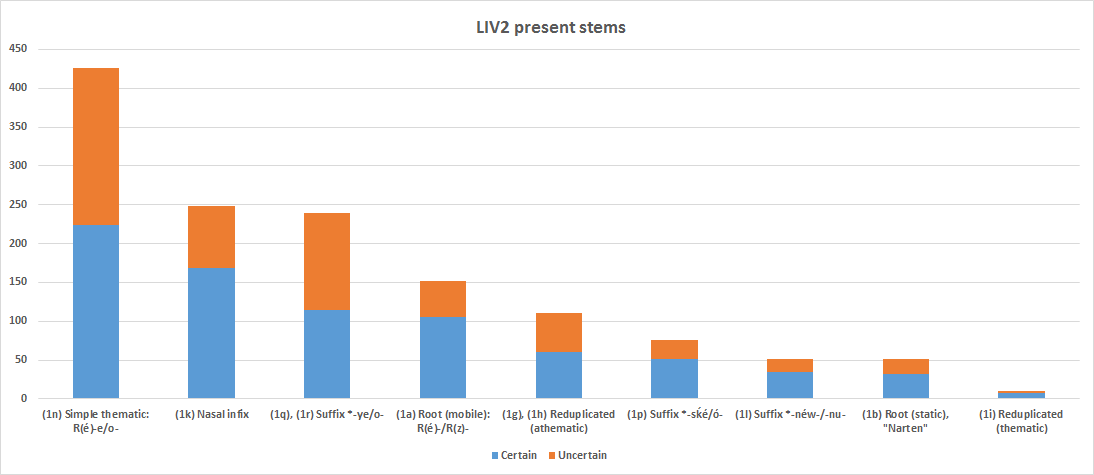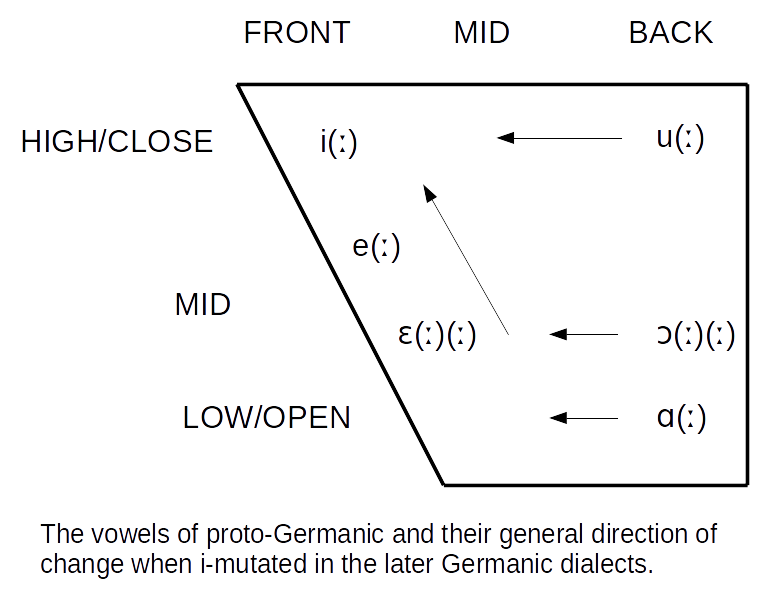|
Preterite-present
The Germanic language family is one of the language groups that resulted from the breakup of Proto-Indo-European (PIE). It in turn divided into North, West and East Germanic groups, and ultimately produced a large group of mediaeval and modern languages, most importantly: Danish, Norwegian, and Swedish (North); English, Dutch and German (West); and Gothic (East, extinct). The Germanic verb system lends itself to both descriptive (synchronic) and historical (diachronic) comparative analysis. This overview article is intended to lead into a series of specialist articles discussing historical aspects of these verbs, showing how they developed out of PIE, and how they came to have their present diversity. Verb types The Germanic verb system carried two innovations over the previous Proto-Indo-European verb system: # Simplification to two tenses: present (also conveying future meaning) and past (sometimes called "preterite" and conveying the meaning of all of the followin ... [...More Info...] [...Related Items...] OR: [Wikipedia] [Google] [Baidu] |
Proto-Indo-European Verb
Proto-Indo-European verbs reflect a complex system of morphology, more complicated than the substantive, with verbs categorized according to their grammatical aspect, aspect, using multiple grammatical moods and grammatical voice, voices, and being grammatical conjugation, conjugated according to grammatical person, person, grammatical number, number and grammatical tense, tense. In addition to finite forms thus formed, non-finite forms such as participles are also extensively used.Beekes, 18.1.1. The verbal system is clearly represented in Ancient Greek and Vedic Sanskrit, which closely correspond in nearly all aspects of their verbal systems, and are two of the most well-understood of the early daughter languages of Proto-Indo-European language, Proto-Indo-European. Basics The reconstruction of Grammatical_conjugation, verb conjugation in Proto-Indo-European is controversial. The system described here is known as the "Warren Cowgill, Cowgill–Helmut Rix, Rix" system, which ex ... [...More Info...] [...Related Items...] OR: [Wikipedia] [Google] [Baidu] |
Proto-Germanic
Proto-Germanic (abbreviated PGmc; also called Common Germanic) is the linguistic reconstruction, reconstructed proto-language of the Germanic languages, Germanic branch of the Indo-European languages. Proto-Germanic eventually developed from Germanic parent language, pre-Proto-Germanic into three Germanic branches during the fifth century BC to fifth century AD: West Germanic languages, West Germanic, East Germanic languages, East Germanic and North Germanic languages, North Germanic. North Germanic remained in language contact, contact with the other branches over a considerable time, especially with the Ingvaeonic languages (including History of English, English), which arose from West Germanic dialects, and had remained in contact with the Proto-Norse language, Norse. A defining feature of Proto-Germanic is the completion of the process described by Grimm's law, a set of sound changes that occurred between its status as a dialect of Proto-Indo-European language, Proto-Indo- ... [...More Info...] [...Related Items...] OR: [Wikipedia] [Google] [Baidu] |
Gothic Language
Gothic is an extinct language, extinct East Germanic languages, East Germanic language that was spoken by the Goths. It is known primarily from the ''Codex Argenteus'', a 6th-century copy of a 4th-century Bible translation, and is the only East Germanic language with a sizeable text corpus. All others, including Burgundian language (Germanic), Burgundian and Vandalic language, Vandalic, are known, if at all, only from proper names that survived in historical accounts, and from loanwords in other, mainly Romance languages, Romance, languages. As a Germanic language, Gothic is a part of the Indo-European languages, Indo-European language family. It is the earliest Germanic language that is attested in any sizable texts, but it lacks any modern descendants. The oldest documents in Gothic date back to the fourth century. The language was in decline by the mid-sixth century, partly because of the military defeat of the Goths at the hands of the Franks, the elimination of the Goths ... [...More Info...] [...Related Items...] OR: [Wikipedia] [Google] [Baidu] |
Germanic Languages
The Germanic languages are a branch of the Indo-European languages, Indo-European language family spoken natively by a population of about 515 million people mainly in Europe, North America, Oceania, and Southern Africa. The most widely spoken Germanic language, English language, English, is also the world's most List of languages by total number of speakers, widely spoken language with an estimated 2 billion speakers. All Germanic languages are derived from Proto-Germanic language, Proto-Germanic, spoken in Iron Age Scandinavia, History of Germany#Iron Age, Iron Age Northern Germany and along the North Sea and Baltic coasts. The West Germanic languages include the three most widely spoken Germanic languages: English language, English with around 360–400 million native speakers; German language, German, with over 100 million native speakers; and Dutch language, Dutch, with 24 million native speakers. Other West Germanic languages include Afrikaans, an offshoot of Dutch origi ... [...More Info...] [...Related Items...] OR: [Wikipedia] [Google] [Baidu] |
Reduplication
In linguistics, reduplication is a Morphology (linguistics), morphological process in which the Root (linguistics), root or Stem (linguistics), stem of a word, part of that, or the whole word is repeated exactly or with a slight change. The classic observation on the semantics of reduplication is Edward Sapir, Edward Sapir's: "Generally employed, with self-evident symbolism, to indicate such concepts as distribution, plurality, repetition, customary activity, increase of size, added intensity, continuance." It is used in inflections to convey a grammatical function, such as plurality or intensification, and in Lexicon, lexical Derivation (linguistics), derivation to create new words. It is often used when a speaker adopts a tone more expressive or figurative than ordinary speech and is also often, but not exclusively, Iconicity, iconic in meaning. It is found in a wide range of languages and language groups, though its level of Productivity (linguistics), linguistic productivit ... [...More Info...] [...Related Items...] OR: [Wikipedia] [Google] [Baidu] |
Germanic Umlaut
The Germanic umlaut (sometimes called i-umlaut or i-mutation) is a type of linguistic umlaut (linguistics), umlaut in which a back vowel changes to the associated front vowel (fronting (phonology), fronting) or a front vowel becomes closer to (raising (phonetics), raising) when the following syllable contains , , or . It took place separately in various Germanic languages starting around 450 or 500 Common Era, CE and affected all of the early languages except Gothic language, Gothic. An example of the resulting vowel alternation is the English plural ''foot ~ feet'' (from Proto-Germanic , pl. ). Germanic umlaut, as covered in this article, does not include other historical vowel phenomena that operated in the history of the Germanic languages such as Germanic a-mutation and the various language-specific processes of u-mutation (other), u-mutation, nor the earlier Indo-European ablaut (''vowel gradation''), which is observable in the conjugation of Germanic strong ver ... [...More Info...] [...Related Items...] OR: [Wikipedia] [Google] [Baidu] |
Old High German
Old High German (OHG; ) is the earliest stage of the German language, conventionally identified as the period from around 500/750 to 1050. Rather than representing a single supra-regional form of German, Old High German encompasses the numerous West Germanic languages, West Germanic dialects that had undergone the set of sound change, consonantal changes called the High German consonant shift, Second Sound Shift. At the start of this period, dialect areas reflected the territories of largely independent tribal kingdoms, but by 788 the conquests of Charlemagne had brought all OHG dialect areas into a single polity. The period also saw the development of a stable linguistic border between German and Gallo-Romance languages, Gallo-Romance, later French language, French. Old High German largely preserved the synthetic language, synthetic inflectional system inherited from its ancestral Germanic forms. The eventual disruption of these patterns, which led to the more analytic language ... [...More Info...] [...Related Items...] OR: [Wikipedia] [Google] [Baidu] |
Productivity (linguistics)
In linguistics, productivity is the degree to which speakers of a language use a particular grammatical process, especially in word formation. It compares grammatical processes that are in frequent use to less frequently used ones that tend towards lexicalization. Generally the test of productivity concerns identifying which grammatical forms would be used in the coining of new words: these will tend to only be converted to other forms using productive processes. Examples in English In standard English, the formation of preterite and past participle forms of verbs by means of ablaut (as Germanic strong verbs, for example, ''sing''–''sang''–''sung'') is no longer considered productive. Newly coined verbs in English overwhelmingly use the 'weak' (regular) ending ''-ed'' for the past tense and past participle (for example, '' spammed'', '' e-mailed''). Similarly, the only clearly productive plural ending is ''-(e)s''; it is found on the vast majority of English count ... [...More Info...] [...Related Items...] OR: [Wikipedia] [Google] [Baidu] |
Ablaut
In linguistics, the Indo-European ablaut ( , from German ) is a system of apophony (regular vowel variations) in the Proto-Indo-European language (PIE). An example of ablaut in English is the strong verb ''sing, sang, sung'' and its related noun ''song'', a paradigm inherited directly from the Proto-Indo-European stage of the language. Traces of ablaut are found in all modern Indo-European languages, though its prevalence varies greatly. History of the concept The phenomenon of Indo-European ablaut was first recorded by Sanskrit grammarians in the later Vedic period (roughly 8th century BCE), and was codified by Pāṇini in his ''Aṣṭādhyāyī'' (4th century BCE), where the terms ' and '' '' were used to describe the phenomena now known respectively as the ''full grade'' and ''lengthened grade''.Burrow, §2.1. In the context of European languages, the phenomenon was first described in the early 18th century by the Dutch linguist Lambert ten Kate, in his book ''G ... [...More Info...] [...Related Items...] OR: [Wikipedia] [Google] [Baidu] |
Koine Greek
Koine Greek (, ), also variously known as Hellenistic Greek, common Attic, the Alexandrian dialect, Biblical Greek, Septuagint Greek or New Testament Greek, was the koiné language, common supra-regional form of Greek language, Greek spoken and written during the Hellenistic period, the Roman Empire and the early Byzantine Empire. It evolved from the spread of Greek following the conquests of Alexander the Great in the fourth century BC, and served as the lingua franca of much of the Mediterranean region and the Middle East during the following centuries . It was based mainly on Attic Greek, Attic and related Ionic Greek, Ionic speech forms, with various admixtures brought about through dialect levelling with other varieties. Koine Greek included styles ranging from conservative literary forms to the spoken vernaculars of the time. As the dominant language of the Byzantine Empire, it developed further into Medieval Greek, which then turned into Modern Greek. Literary Koine was ... [...More Info...] [...Related Items...] OR: [Wikipedia] [Google] [Baidu] |
Ancient Greek
Ancient Greek (, ; ) includes the forms of the Greek language used in ancient Greece and the classical antiquity, ancient world from around 1500 BC to 300 BC. It is often roughly divided into the following periods: Mycenaean Greek (), Greek Dark Ages, Dark Ages (), the Archaic Greece, Archaic or Homeric Greek, Homeric period (), and the Classical Greece, Classical period (). Ancient Greek was the language of Homer and of fifth-century Athens, fifth-century Athenian historians, playwrights, and Ancient Greek philosophy, philosophers. It has contributed many words to English vocabulary and has been a standard subject of study in educational institutions of the Western world since the Renaissance. This article primarily contains information about the Homeric Greek, Epic and Classical periods of the language, which are the best-attested periods and considered most typical of Ancient Greek. From the Hellenistic period (), Ancient Greek was followed by Koine Greek, which is regar ... [...More Info...] [...Related Items...] OR: [Wikipedia] [Google] [Baidu] |





